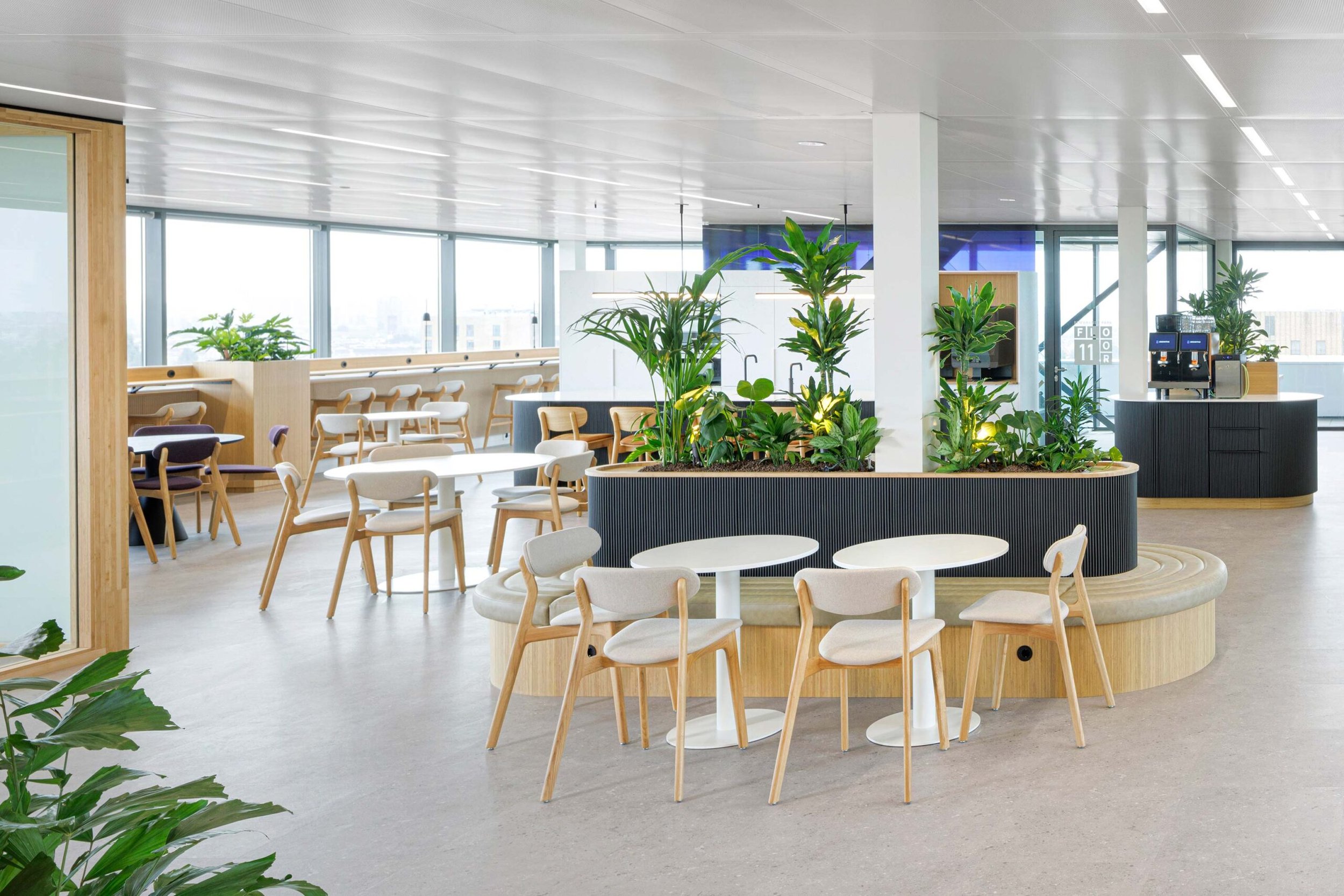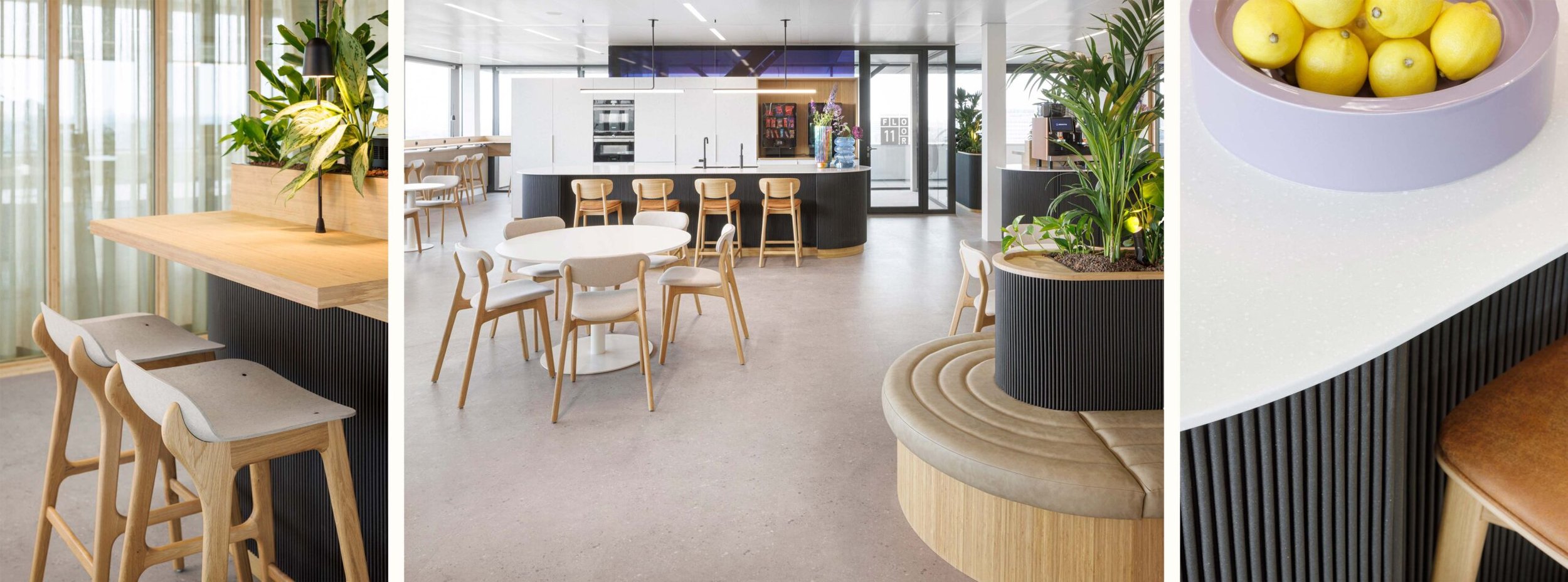
.Office - Rembrandtpark
Innovative Design Meets Sustainability: A Collaboration at Rembrandtpark
At PLANQ, we believe in rethinking materials, reimagining sustainability, and redefining the possibilities of circular design. Our partnership in the realization of a state-of-the-art office building overlooking Rembrandtpark is a testament to these values. Designed by the talented Maaike Veenstra and Studio Anne Witten, the project exemplifies how sustainability and innovative design can harmonise to create an inspiring, eco-conscious workspace.
This BREEAM-certified building stands as a beacon for environmental responsibility, social values, and thoughtful material choices.
PLANQ’s circular furniture was a perfect fit for the project’s vision of sustainability and functionality. We had the pleasure of interviewing the design team behind this project, Anne Witten and Maaike Veenstra, who offered invaluable insights into the design process, challenges of sourcing sustainable materials, and the role of circular design in shaping exceptional interiors.
FACTS & FIGURES
Location: Amsterdam
Architect: Studio Anne Witten +
Maaike Veenstra Interieurontwerp & Styling
Dealer: SKO
Photography: Ewoud Huibers
Interview Anne, Architect and Maaike, Interior Designer & Stylist
What was the overall design concept or vision for this project? How did PLANQ furniture fit into that vision?
“The project was driven by the client’s ethos of sustainability and circularity. These values were reflected in every decision, from material sourcing to furniture selection.
The building is BREEAM-certified, meaning environmental and social values are paramount. Working with innovative brands like PLANQ, where sustainability is central, was crucial to ensuring a positive lifecycle for the building. Your furniture fit perfectly with this vision!”
When you first encountered PLANQ furniture, what aspects stood out to you, and how did they influence your design decisions?
“PLANQ’s blend of soft design language, natural colour palettes, and use of sustainable materials.
The soft shapes, fresh accent colours, and eco-friendly materials aligned seamlessly with the project’s concept. While the furniture didn’t directly influence the design, it was a perfect match for our overall vision.”
How did you balance functionality and aesthetics when selecting our furniture?
“The PLANQ pieces were chosen for their ability to complement the project’s natural tones while providing outstanding comfort.
“With natural tones like jute coffee bags, recycled leather, and fabrics in soft hues, the furniture integrated effortlessly into the design. Thanks to the seating comfort of the furniture, functionality and aesthetics are well balanced.”
Sustainability has become a key focus in modern design. How did sustainability shape your overall approach to this latest project, and what specific goals were you hoping to achieve?
”The goal was to find the most sustainable version of each material and furniture piece—within the set budget and the conceptual framework.”
In terms of material selection and building methods, what sustainable practices or innovations did you incorporate into the design?
”The building was constructed following BREEAM certification, and we added many sustainable elements to it, including:
The wood we use is bamboo—a grass species that is fundamentally more sustainable than most types of wood, although bamboo has its drawbacks.
Design classics from Artifort were selected—chairs that can be reupholstered and retain their “visual value.”
Meeting tables are made from "textile waste" or sourced from DUM Office, which uses water-based lacquer on the beech tabletops.
And, of course, furniture from Planq!
The kitchen and pantry are entirely constructed from recycled yogurt container material, with recycled leather accents from Buxkin.”
How do you see sustainable design evolving, and what role do brands like PLANQ play in this evolution?
Maaike and Anne emphasised the growing demand for sustainable solutions in the business sector, coupled with a desire for transparency about the origins, footprints, and recycling processes of products.
“As designers, it’s our responsibility to recommend materials that contribute to a better world. Brands like PLANQ are indispensable in this development. By continually innovating and offering fresh models and material choices, they make sustainability accessible and exciting for both architects and clients.”
At PLANQ, we pride ourselves on thinking outside the box to create furniture that tells a story. By transforming post-consumer textile waste into high-quality furniture,
we’re closing the loop on materials and helping businesses meet their sustainability goals.
This project at Rembrandtpark showcases what’s possible when bold design meets a commitment to the planet. Through collaboration with forward-thinking designers like the team behind this project, we’re proving that sustainable design isn’t just functional—it’s beautiful, inspiring, and essential for the future.
The Rembrandtpark office project is more than just a building - it’s a statement of what sustainable design can achieve. By incorporating circular materials, thoughtful layouts,
and PLANQ’s innovative furniture, it sets a benchmark for future projects that prioritise environmental and social responsibility.
Let’s continue to push the boundaries of design, together.







